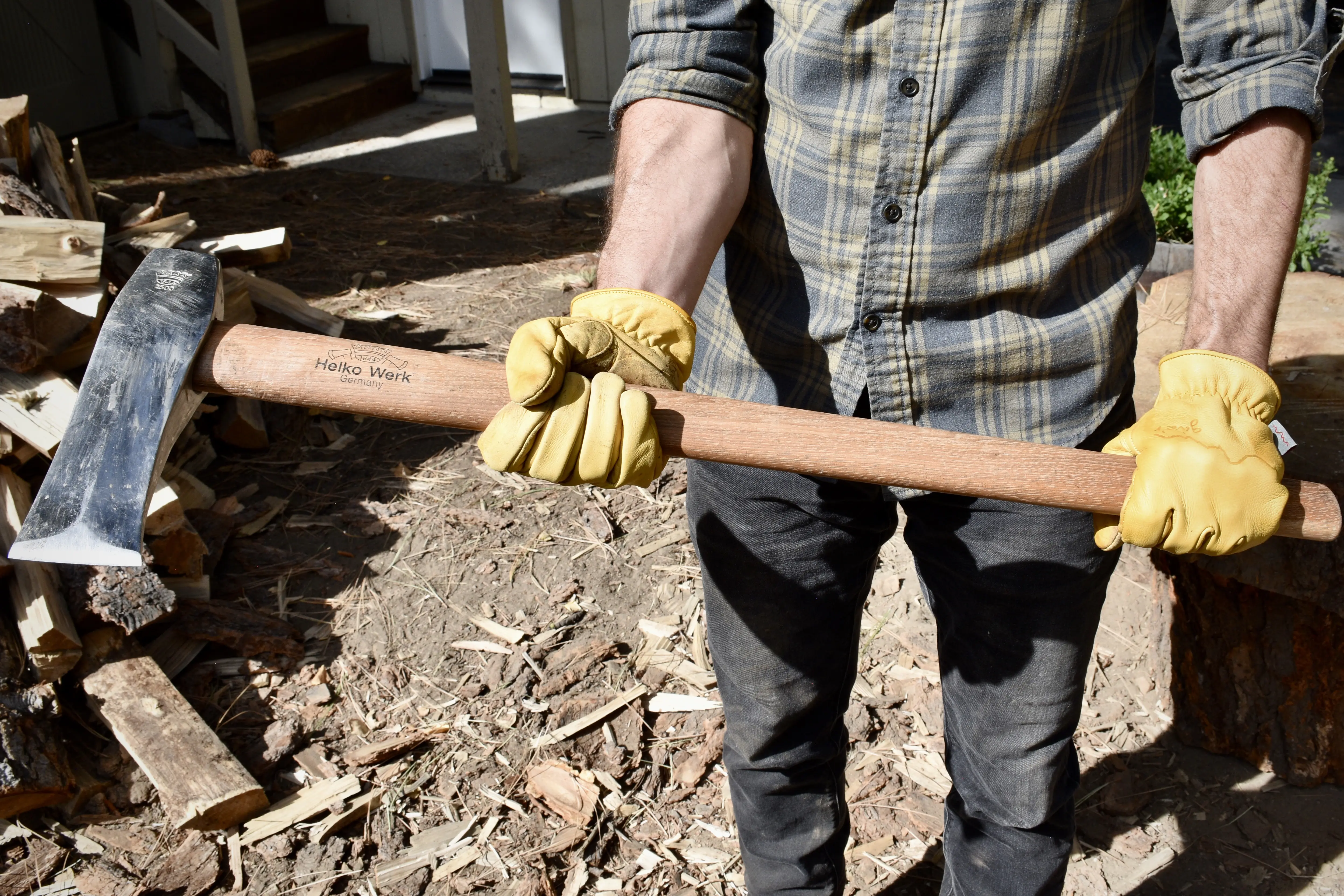Are you tired of struggling with tough, stubborn logs every time you need firewood? Finding the best tool to split wood can make your work faster, safer, and even enjoyable.
Whether you’re a weekend warrior or a seasoned pro, the right tool changes everything. You’ll discover the top options that match your needs and skill level—so you can get the job done right without wasting energy or risking injury. Keep reading to find the perfect wood-splitting tool that fits your hands and your firewood pile.

Credit: www.amazon.com
Types Of Wood Splitting Tools
Splitting wood is easier with the right tool. Different tools work better for certain jobs.
Understanding each tool helps you choose the best one for your wood splitting needs.
Manual Axes And Hatchets
Manual axes and hatchets are hand tools for splitting small to medium logs. They are lightweight and easy to carry.
Axes have a long handle and sharp blade. Hatchets are smaller and good for kindling or light work.
- Good for small jobs and camping
- Require physical strength and skill
- Affordable and simple to use
Mauls And Sledgehammers
Mauls are heavy tools with a wedge-shaped head. They are designed to split large logs by force.
Sledgehammers are used with a splitting wedge. They deliver strong blows to split tough wood.
- Ideal for big and hard wood pieces
- Require more effort but work well
- Durable and long-lasting tools
Hydraulic Splitters
Hydraulic splitters use fluid pressure to push a wedge through wood. They split logs quickly and with less effort.
These splitters are common for heavy-duty work. They need power sources like a pump or motor.
- Split large logs smoothly
- Reduce physical strain on the user
- Usually found in professional use
Electric And Gas-powered Splitters
Electric and gas-powered splitters use engines to drive the splitting mechanism. They offer fast and strong splitting.
Electric models are quieter and good for small to medium jobs. Gas-powered splitters are powerful and portable.
- Electric splitters need an outlet or battery
- Gas splitters work anywhere without power
- Both save time and effort

Credit: www.reddit.com
Factors To Consider When Choosing A Tool
Choosing the right tool to split wood is important for safety and efficiency. Different tools work better for certain wood types and tasks.
Think about what kind of wood you will split and how often you will use the tool. Also, consider your physical ability and budget before making a choice.
Wood Type And Size
Hardwood like oak or hickory needs a stronger, heavier tool. Softwood such as pine splits easier and may need less force.
- Small logs and kindling require a small axe or hatchet.
- Medium to large logs may need a splitting maul or wedges.
- Wet or green wood is harder to split than dry wood.
Frequency Of Use
If you split wood often, durability and comfort are key. A tool that feels good in your hands and lasts a long time will save effort.
| Use Frequency | Recommended Tool |
| Occasional | Basic axe or hatchet |
| Regular | Heavy-duty splitting maul |
| Professional | Hydraulic splitter or power tool |
Physical Strength And Safety
Choose a tool that matches your strength to avoid injury. Lightweight tools are easier for beginners or less strong users.
- Wear gloves and eye protection.
- Keep your feet clear of the blade path.
- Use a stable surface to split wood.
- Maintain a firm grip on the handle.
Budget And Maintenance
Tools vary in price and upkeep. Some need sharpening, others require oiling or cleaning to last longer.
- Cheap tools may wear out faster.
- Invest in quality for frequent use.
- Check if replacement parts are available.
- Regular maintenance extends tool life.
Top Tools For Wood Splitting In 2025
Splitting wood is easier with the right tool. Different tools fit different needs. This guide helps you find the best splitter for your tasks in 2025.
From manual to hydraulic, each tool type has its strengths. Choose based on your wood size, effort level, and budget.
Best Manual Tool
Manual tools are simple and portable. They do not need fuel or electricity. They work well for small amounts of wood and light work.
- Splitting Maul: Heavy and wedge-shaped for strong impact.
- Froe: Used for splitting thin wood pieces along the grain.
- Hatchet: Good for kindling and small logs.
Best Electric Splitter
Electric splitters run on power cords or batteries. They are quieter and cleaner than gas models. Ideal for light to medium jobs at home.
| Feature | Benefit |
|---|---|
| Lightweight | Easy to move around the yard |
| Low noise | Can be used in quiet neighborhoods |
| Less maintenance | No fuel or oil changes needed |
Best Gas-powered Splitter
Gas splitters offer high power and mobility. They handle large logs and heavy work. Great for frequent use in remote areas without electricity.
- Strong engine for fast splitting
- Portable with no cords
- Needs regular fuel and oil maintenance
Best Hydraulic Splitter
Hydraulic splitters use fluid pressure for strong and smooth action. They work well for large volumes of wood. Often used by professionals and serious users.
| Type | Power Source | Best Use |
|---|---|---|
| Manual | Human effort | Small jobs, portable |
| Electric | Electricity | Light to medium tasks |
| Gas-Powered | Gas engine | Heavy-duty, outdoor |
| Hydraulic | Hydraulic fluid | Large volume, professional |
Tips For Safe And Efficient Wood Splitting
Splitting wood can be hard work. Using the right tools and methods keeps you safe.
These tips will help you split wood faster and avoid injuries.
Proper Stance And Technique
Stand with your feet shoulder-width apart for balance. Keep your back straight.
Swing your splitting tool in a controlled motion. Aim for the wood center.
- Place the wood on a stable surface.
- Hold the tool firmly with both hands.
- Bring the tool over your shoulder.
- Use your legs and arms to swing down.
- Follow through to split the wood fully.
Protective Gear
Always wear safety gear before splitting wood. This prevents injuries from flying wood chips.
- Wear safety glasses to protect your eyes.
- Use heavy gloves to protect your hands.
- Wear steel-toed boots to protect your feet.
- Consider ear protection if using power tools.
Maintaining Your Tools
Keep your splitting tools sharp and clean. Dull tools need more force and are unsafe.
| Tool | Maintenance Tip |
| Axe | Sharpen blade regularly and oil handle |
| Splitting Maul | Check for cracks and keep head tight |
| Wedges | Remove rust and store dry |
| Chainsaw | Sharpen chain and check fuel |
Handling Different Wood Types
Wood type affects how you split it. Hard woods need more force than soft woods.
- Soft wood: Use lighter tools and less force.
- Hard wood: Use heavier mauls or wedges.
- Wet wood: Let it dry to split easier.
- Knots: Aim carefully or split around them.
Comparing Costs And Value
Choosing the right tool to split wood depends on many factors. Costs and value play a big role in this choice.
Knowing the expenses and benefits helps you pick the best tool for your needs and budget.
Initial Investment
Initial costs vary widely between manual and powered wood splitters. Manual tools often cost less upfront but require more physical effort.
- Manual axes and mauls are usually cheaper.
- Electric and gas-powered splitters have higher initial prices.
- Hydraulic splitters cost the most but offer easier splitting.
Operating Expenses
Operating costs include fuel, electricity, and maintenance. Manual tools need no fuel but may need sharpening.
| Tool Type | Fuel/Electricity | Maintenance |
| Manual Axe | None | Sharpening, handle care |
| Electric Splitter | Electricity | Motor and blade check |
| Gas Splitter | Gasoline | Engine tune-up, oil change |
Longevity And Durability
Durability depends on tool quality and use. Metal parts last longer but need care to avoid rust and wear.
- Manual tools can last many years with proper care.
- Electric splitters last well but need electrical safety checks.
- Gas splitters require regular engine maintenance for longevity.
Resale Value
Resale value depends on brand, condition, and market demand. Powered splitters often keep more value than manual tools.
| Tool Type | Average Resale Value |
|---|---|
| Manual Axe | 20-40% of original price |
| Electric Splitter | 40-60% of original price |
| Gas Splitter | 50-70% of original price |

Credit: gearjunkie.com
Frequently Asked Questions
What Is The Best Tool To Split Wood Efficiently?
The best tool to split wood efficiently is a splitting maul. It combines an axe blade with a sledgehammer head, making it ideal for splitting large logs quickly and with less effort.
How Does A Splitting Axe Differ From A Regular Axe?
A splitting axe has a wider, wedge-shaped blade designed to split wood fibers apart. Regular axes have thinner blades meant for cutting across the grain, making splitting less efficient.
Can Electric Log Splitters Replace Manual Tools?
Yes, electric log splitters can replace manual tools for faster, easier splitting. They use hydraulic power to split logs with minimal physical effort, ideal for frequent or large-volume wood splitting.
What Safety Gear Is Needed When Splitting Wood?
Safety gear includes gloves, safety glasses, steel-toe boots, and ear protection. These protect against splinters, flying debris, and accidental tool slips during wood splitting.
Conclusion
Choosing the best tool to split wood depends on your needs and strength. Axes work well for small to medium logs. Wedges and mauls help with tougher, larger wood. Hydraulic and electric splitters save time and effort for big jobs.
Think about safety and ease when picking a tool. The right choice makes splitting wood faster and less tiring. Try different tools to find what fits you best. Wood splitting can be simple with the right tool in hand.


